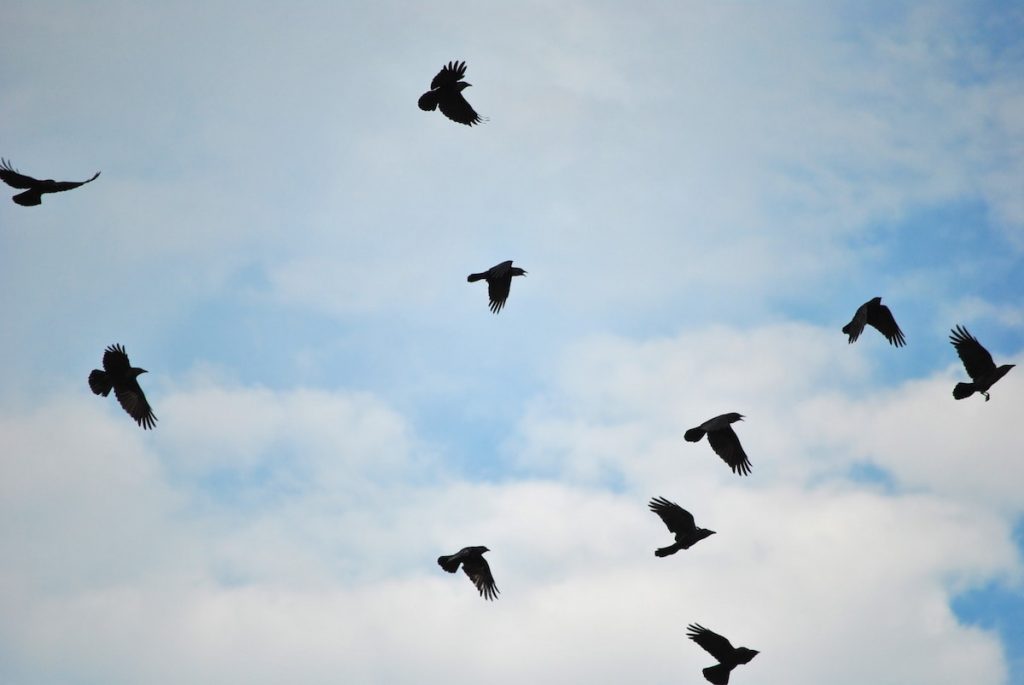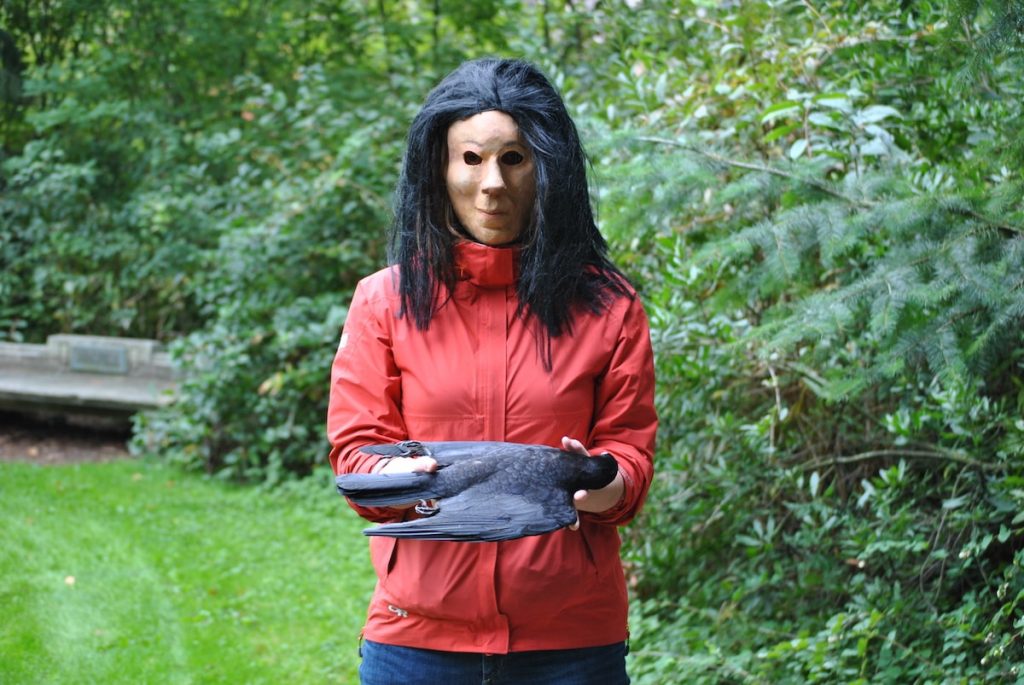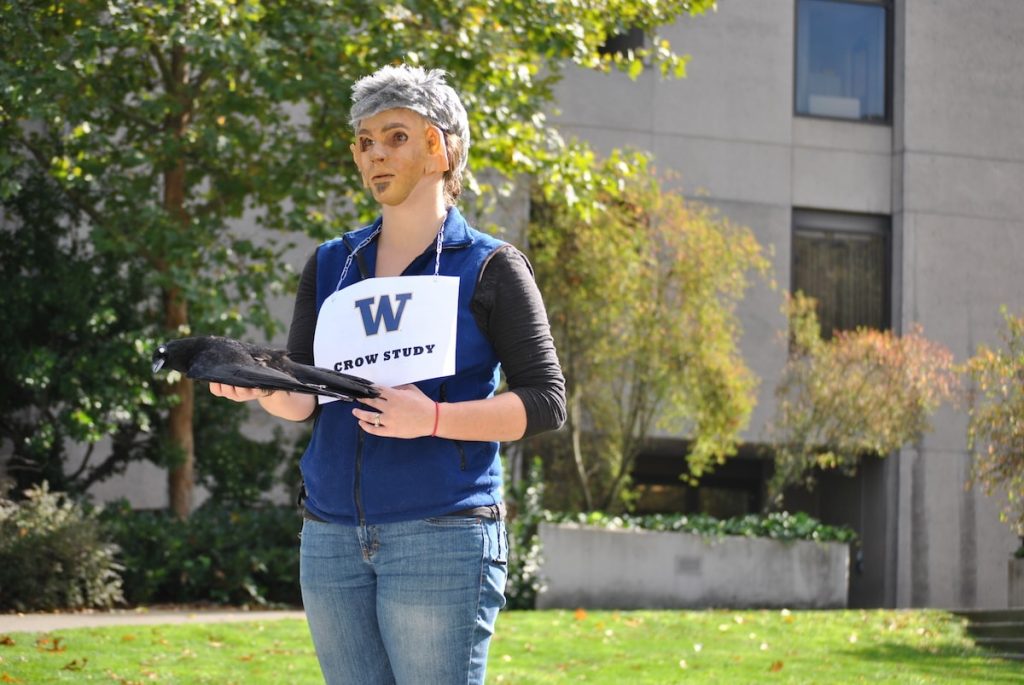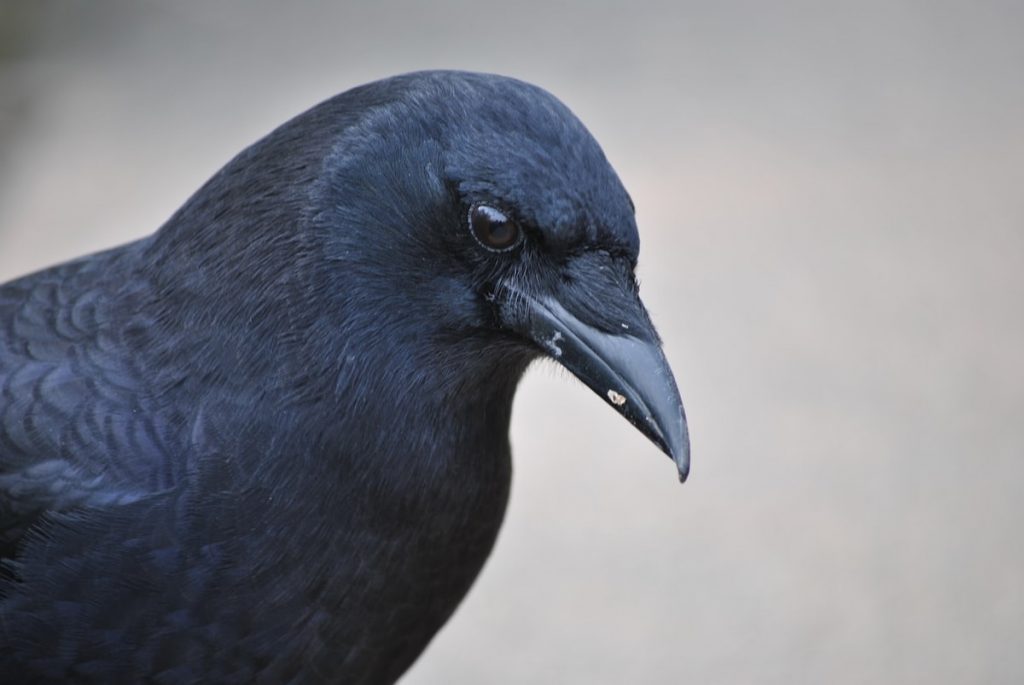Crows, A Bird That’s Not Bird-Brained
10:48 minutes

As the November gloom intensifies, you might be seeing more crows and ravens in hovering in the sky. And maybe you’re thinking, like Dutch start-up Crowbar is, that all of those birds could somehow be useful…perhaps cleaning up litter, or finding change on the ground?
It certainly seems reasonable. These are smart birds, after all. American crows recognize faces, and have been seen gathering around dead crows in so-called “funerals”—and will attack humans that they associate with dead crows. On the other side of the world, New Caledonian crows have been observed using and even making tools to collect insects.
[How the west will be won, for the black-footed ferret.]
But crow researchers aren’t so sure we can commercialize these cunning corvids. Kaeli Swift, a Ph.D. candidate at the University of Washington in Seattle, says crows might actually be too smart to be co-opted.
See a video of these intelligent crows using tools here. And view photos from Swift’s crow studies at the University of Washington below.







Kaeli Swift is a postdoctoral researcher at the University of Washington in Seattle.
IRA FLATOW: This is Science Friday. I’m Ira Flatow. You know, over the years, we’ve been discovering just how smart crows are. We’ve seen them build tools. You know they’re pretty smart.
But have you ever seen a crow playing games? Yeah. Whether it’s surfing down a snowy roof, dropping objects from on high and then zooming to catch them, or other kinds of merriment, these are smart birds we’re talking about. And they’re so smart that one company, Dutch startup called Crowbar, wants to train them to pick up cigarette butts and other litter in exchange for food.
But my next guest, herself a big believer in those brainy birds, thinks that, well, might be a step just too far. Kaeli Swift is a PhD candidate in ornithology at the University of Washington in Seattle. Welcome to Science Friday.
KAELI SWIFT: Hi, Ira. Thank you for having me.
IRA FLATOW: Crows, they are smarter than the average bird, aren’t they?
KAELI SWIFT: They truly are, yeah. When we look at some of the features of their cognition, like you mentioned tool use or causal reasoning, or even if we just look at the relative size of their brain, they’re really, really impressive birds.
IRA FLATOW: They have facial recognition, don’t they?
KAELI SWIFT: They do, yes. So we’ve been able to demonstrate that here at the University of Washington in a variety of studies– one, where we looked at whether or not they would remember people who caught them, which is sort of a scary, intense experience for a crow. And we found that not only did the birds that were captured recall the people that had done that, but they actually spread that information.
IRA FLATOW: Wow.
KAELI SWIFT: And we know that they’ll remember people that they see doing other kinds of dangerous things– a little bit more nuanced, though, like holding dead crows.
IRA FLATOW: They’ll remember you holding a dead crow, and do they think you killed it?
KAELI SWIFT: So that’s what we think that they’re inferring. In our experiments, when we demonstrated that, we were careful that the people holding the dead crows didn’t do anything. We weren’t playing any kinds of distress calls. They weren’t rough handling the crows. So if they did interpret that this person killed it, it was purely by proximity. But that’s still really impressive.
IRA FLATOW: So Alfred Hitchcock was right to cast crows in “The Birds.”
KAELI SWIFT: [LAUGHS] Well, so I always say, you know as a fan of cinema, you can’t help but love that movie. However, I know that he really liked these animals, but I think he did them a great disservice in “The Birds,” because gathering in large numbers is a really important and common part of this bird’s behavioral repertoire. And so, because of that, because they’re inclined to get into these large groups, now there’s the sort of permanent, creepy association with seeing an event like that.
IRA FLATOW: Yeah. We have some photos of your research on our website at sciencefriday.com/crows. And you have to tell me about the masks you use.
KAELI SWIFT: [LAUGHS] Yeah, so in that original facial recognition study pioneered by John Marzluff, what they were interested in looking at is can a wild animal learn and recognize a human face? And so to ask that question, they wanted to be able– and again, because they were keying in specifically on the face– they wanted to be able to have some flexibility with what size or different kinds of people. Can we trade faces, so to speak, and will the birds still recognize them? Is that the part that they’re keying in on?
So, that’s why the masks were important in that study. But one of the other elements is we didn’t want to use– for the bulk of the study, we didn’t want to use these kind of exaggerated, really caricature-type masks that you would buy at a typical Halloween store, both because they’re sort of– in some ways they don’t really resemble human face because they’re so exaggerated and because they often have facial expressions sort of inherently tied to them. They’re looking angry, or they’re looking extremely happy.
So we actually had costume makers come and take molds of volunteers’ faces to make these expressionless, very plain faces. And the outcome of that is that they’re effective. They look more like just a normal person. But for that reason, and because they often sort of cast shadows over the eyes a little bit, they come across as extremely creepy to the average human being.
IRA FLATOW: They do. [LAUGHS] They look at us as creepy. OK.
KAELI SWIFT: [LAUGHS]
IRA FLATOW: And one of the things you do out of your work is a Twitter game called Crow or No Crow, which we’re going to play on Twitter with you next week. And are there any dead giveaway– so sorry about that language– that something’s a crow or not, like, say, a raven?
KAELI SWIFT: Yeah. So there are a couple key features just based on appearance alone that are really helpful for distinguishing crows from other black corvids, like ravens or even other black birds. Because not every black bird is a corvid or related closely to a crow.
The big one when you’re comparing things like crows and ravens is that ravens are substantially larger than crows. I always tell people, if you’re unfamiliar with these birds and you’re out and you see something, and you think to yourself, that is the biggest gosh darn crow I’ve ever seen in my life, you’re probably looking at a raven. So there’s that size component. And detecting that in something like a photo, though, that kind of comes with practice, at getting to know proportions, and all of that.
So the more objective features are ravens have these special throat feathers called hackles. And they look– they’re very textured. It looks like a beard. It looks like a bird with a great big beard. And crows don’t have those specialized hackle feathers. They obviously– they have throat feathers, but they don’t have that same kind of fur-like texture to them. They’re much smoother.
And then tail shape is another really good indicator. If you’re able to see these birds in flight, which is often when we see them, ravens have a diamond-shaped tail, and crows have a square tail.
IRA FLATOW: Now interesting. Let’s see if we can get a phone call or two in here before we have to say goodbye. Let’s go to Kevin in Columbia, Missouri. Hi, Kevin.
KEVIN: Hello, Ira. Big fan of your show. Thank you for having me on. My question is, do we have any evidence that crows, ravens understand basic arithmetic? Like can they add like 2 plus 1 is equal to 3? Do they– is there any evidence that they understand basic numbers or can count?
IRA FLATOW: Great question.
KAELI SWIFT: Yeah, that is a great question. And the answer is kind of. So we have done– we have done studies on, I believe it was rooks, which are a European corvid, where we showed that they have some sense of quantity, of greater quantities.
But the way that they understand numbers is not the same way that you and I, as human beings, understand numbers. So, yes, they can do things that sort of the outcome of which is that they’re counting. But they’re not counting the way that we do.
IRA FLATOW: How can we– I mentioned all the ways that crows can play. How do we observe crows playing, or at least test their smarts ourselves?
KAELI SWIFT: Yeah, so play is a really fascinating area of research. And to go on and on about that, I would take up the rest of your show. But suffice it to say that for the average person to see playing, it’s really just about taking the time to observe animals. Right? Just the way that we observe playing in our pets– the reason we get to see those kinds of behaviors is because we spend a lot of time looking at them and observing them.
I think my favorite story of observing play in corvids is in the Seattle area, we have these trees that make these really round cones that they distribute all over the city. They’re about the size and shape of a ping pong ball. And I was watching this crow, and it would grab the cone, and it would fly up really high, and then it would drop it. But it would fly down and catch it right before it hit the ground. And it would fly back up, drop it.
So again, it wasn’t trying to do anything for the purpose of cracking open this cone, for example, or something that we could easily attribute to another thing. To me, it sincerely looked like it was just sort of playing with a ball.
IRA FLATOW: Wow. Is there any way to know what a baby crow or young crow looks like? I mean, we see birds all the time and never know adults from the young ones.
KAELI SWIFT: Yeah, that’s an excellent question. And there are two really easy ways to tell them apart. The first is that baby crows and ravens and many other corvids have blue eyes. They’ll transition to brown as they get a little older, but for the first couple of months after they’re out of the nest, they have these bright striking blue irises. Really pretty.
And then the second way is baby birds have what we call the– a gape, which we can use that word to describe the interior mouths of lots of birds. But when we use it in context of young birds or crows, we’re talking about– you know how baby birds have that bit of their bill on the corner, the corners there? It always gives them sort of that crotchety, grumpy look that’s iconic to baby birds? So that’s called the gape.
And what that allows them to do is open their mouths really, really wide so the parents have lots of space to insert food. And in crows, that gape is pink. So if you see a bird with blue eyes or pink at the very corner of its mouth, that’s a baby crow.
IRA FLATOW: Well I’ve got one last question for you. We know how amazing they are using tools, and people have said, why not train them to pick up the trash? Why not?
KAELI SWIFT: Yeah, so that’s a great question. So for me, it’s not an issue of a lack of intelligence or trainability. Like you said, we know that crows, specifically speaking New Caledonian crows, are capable of really impressive feats of multi-step tool use.
So when we ask, is it possible to train wild crows to pick up cigarette butts? I think theoretically it’s totally possible. They have the cognition to do it.
To me, it’s a problem of motivation. Right? If you could go– if all of the things that you and I work to get money for, we could just find for free on the sidewalk, we’d probably skip the step of earning money. And you can make sort of the same analogy with crows picking up cigarette butts. Why would they take the time to go find cigarette butts to get food if they could just go find food?
IRA FLATOW: You mean they’re smart enough to make that calculation?
KAELI SWIFT: I think– you know, I think that cost and effect, a lot of animals– that’s kind of what it means to be a living being is this constant cost and effect analysis. Yeah.
IRA FLATOW: Wow. I’m going to have a whole new view about crows.
KAELI SWIFT: I hope so.
IRA FLATOW: There are a lot of them in my neighborhood. Thank you very much for taking time to be with us today.
KAELI SWIFT: It was my pleasure. Thank you so much.
IRA FLATOW: You’re welcome. Kaeli Swift, PhD candidate in ornithology at the University of Washington in Seattle. And you can see pictures of her work on crow funerals, masks and all, on our website at sciencefriday.com/crows.
Copyright © 2017 Science Friday Initiative. All rights reserved. Science Friday transcripts are produced on a tight deadline by 3Play Media. Fidelity to the original aired/published audio or video file might vary, and text might be updated or amended in the future. For the authoritative record of Science Friday’s programming, please visit the original aired/published recording. For terms of use and more information, visit our policies pages at http://www.sciencefriday.com/about/policies/
Christie Taylor was a producer for Science Friday. Her days involved diligent research, too many phone calls for an introvert, and asking scientists if they have any audio of that narwhal heartbeat.